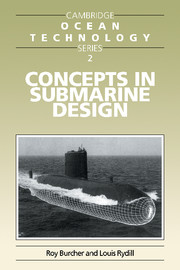Book contents
- Frontmatter
- Contents
- Introduction
- Acknowledgements
- 1 Design in general
- 2 Milestones in submarine history
- 3 Submarine hydrostatics
- 4 The weight/space relationship
- 5 Submarine structures
- 6 Powering of submarines
- 7 Geometric form and arrangements
- 8 Dynamics and control
- 9 Submarine systems
- 10 Considerations of building and costs in design
- 11 Generating a concept design
- Appendix 1 Hydrostatic conditions of flotation
- Appendix 2 Operational practice for keeping in trim
- Appendix 3 Assessing weight and size of variable ballast
- Appendix 4 Submarine pressure hull strength (Prediction of interframe collapse pressures)
- Appendix 5 Estimates of resistance and propulsion
- References and suggested reading
- Index
Appendix 1 - Hydrostatic conditions of flotation
Published online by Cambridge University Press: 05 July 2014
- Frontmatter
- Contents
- Introduction
- Acknowledgements
- 1 Design in general
- 2 Milestones in submarine history
- 3 Submarine hydrostatics
- 4 The weight/space relationship
- 5 Submarine structures
- 6 Powering of submarines
- 7 Geometric form and arrangements
- 8 Dynamics and control
- 9 Submarine systems
- 10 Considerations of building and costs in design
- 11 Generating a concept design
- Appendix 1 Hydrostatic conditions of flotation
- Appendix 2 Operational practice for keeping in trim
- Appendix 3 Assessing weight and size of variable ballast
- Appendix 4 Submarine pressure hull strength (Prediction of interframe collapse pressures)
- Appendix 5 Estimates of resistance and propulsion
- References and suggested reading
- Index
Summary
For a vessel floating on the surface, the hydrostatic properties of relevance are the conditions of flotation and the stability of the vessel in relation to disturbances from the static flotation condition.
It is assumed that the water surface is calm and any movement of the craft is sufficiently slow for any dynamic effects to be discounted.
Accepting Archimedes principle that a vessel will displace its own weight of water, the initial requirement for flotation is that the intact hull is of sufficient volume to displace its own weight whilst having a reasonable freeboard (height of weather deck above the waterline) and that it floats upright. The volume of watertight hull above the waterline constitutes a Reserve of Buoyancy (ROB). This ROB becomes important when considering the safety of the vessel in damaged conditions when water floods part of the hitherto intact displacement volume below the waterline.
The stability of the vessel concerns the outcome of perturbations from the static flotation condition. Sideways motion (sway), change of heading (yaw) and fore or aft motion (surge) do not change the static conditions of the hull and can be considered as neutral. Whereas roll motion (heel), pitching and vertical motion (heave) result in changes in the distribution of buoyant volume and hence variation in the static equilibrium condition. The question to be answered is whether after a disturbance the vessel returns to its initial equilibrium state.
If a vessel heaves upwards then the displacement volume reduces and the excess of unchanged weight over reduced buoyancy provides a force in a direction restoring the vessel to its original position.
Information
- Type
- Chapter
- Information
- Concepts in Submarine Design , pp. 276 - 278Publisher: Cambridge University PressPrint publication year: 1994
